CADILLAC SRX 2008 1.G Owners Manual
Manufacturer: CADILLAC, Model Year: 2008, Model line: SRX, Model: CADILLAC SRX 2008 1.GPages: 448, PDF Size: 5.61 MB
Page 161 of 448
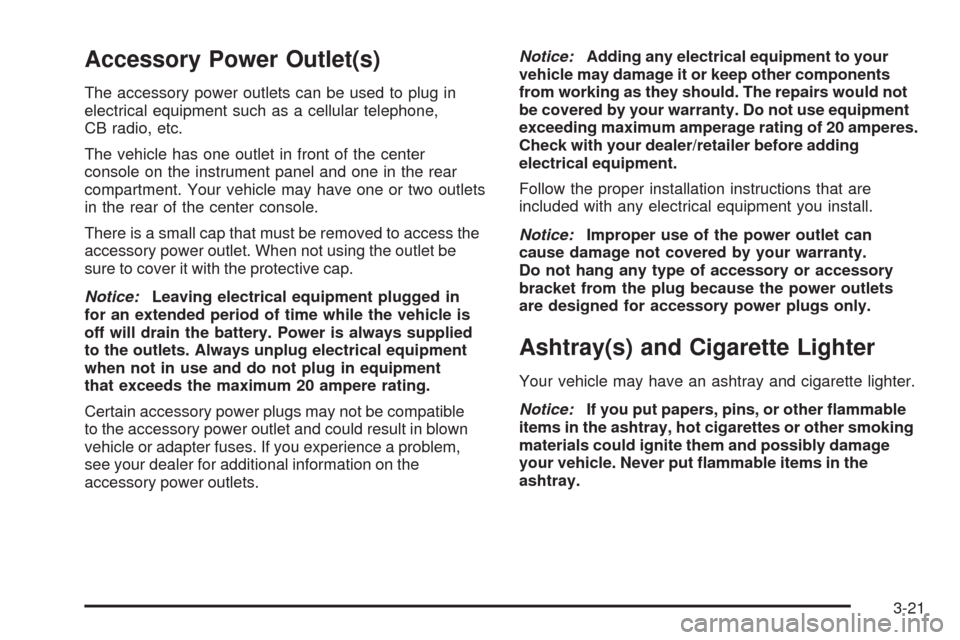
Accessory Power Outlet(s)
The accessory power outlets can be used to plug in
electrical equipment such as a cellular telephone,
CB radio, etc.
The vehicle has one outlet in front of the center
console on the instrument panel and one in the rear
compartment. Your vehicle may have one or two outlets
in the rear of the center console.
There is a small cap that must be removed to access the
accessory power outlet. When not using the outlet be
sure to cover it with the protective cap.
Notice:Leaving electrical equipment plugged in
for an extended period of time while the vehicle is
off will drain the battery. Power is always supplied
to the outlets. Always unplug electrical equipment
when not in use and do not plug in equipment
that exceeds the maximum 20 ampere rating.
Certain accessory power plugs may not be compatible
to the accessory power outlet and could result in blown
vehicle or adapter fuses. If you experience a problem,
see your dealer for additional information on the
accessory power outlets.Notice:Adding any electrical equipment to your
vehicle may damage it or keep other components
from working as they should. The repairs would not
be covered by your warranty. Do not use equipment
exceeding maximum amperage rating of 20 amperes.
Check with your dealer/retailer before adding
electrical equipment.
Follow the proper installation instructions that are
included with any electrical equipment you install.
Notice:Improper use of the power outlet can
cause damage not covered by your warranty.
Do not hang any type of accessory or accessory
bracket from the plug because the power outlets
are designed for accessory power plugs only.
Ashtray(s) and Cigarette Lighter
Your vehicle may have an ashtray and cigarette lighter.
Notice:If you put papers, pins, or other �ammable
items in the ashtray, hot cigarettes or other smoking
materials could ignite them and possibly damage
your vehicle. Never put �ammable items in the
ashtray.
3-21
Page 162 of 448
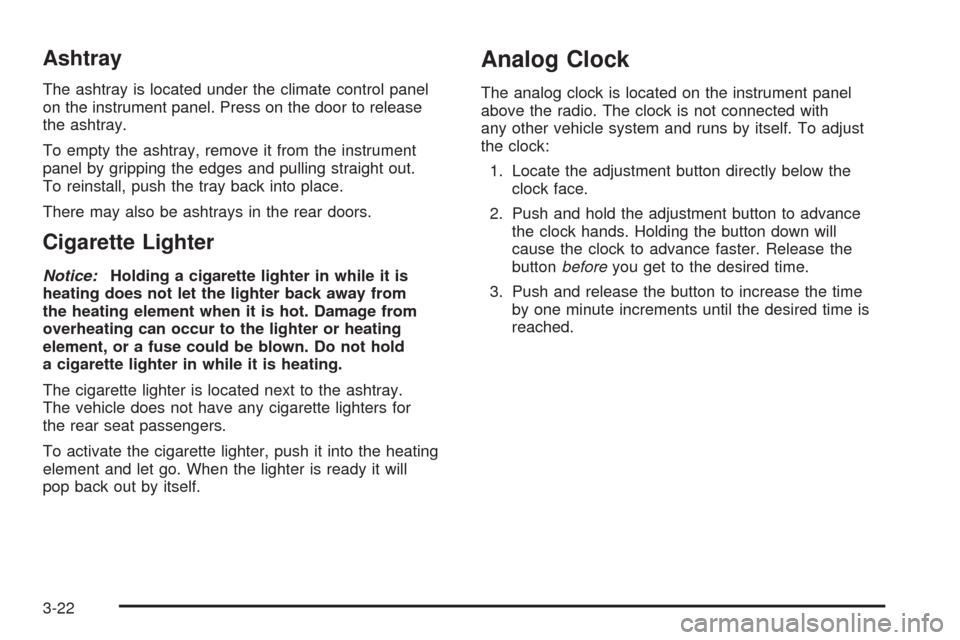
Ashtray
The ashtray is located under the climate control panel
on the instrument panel. Press on the door to release
the ashtray.
To empty the ashtray, remove it from the instrument
panel by gripping the edges and pulling straight out.
To reinstall, push the tray back into place.
There may also be ashtrays in the rear doors.
Cigarette Lighter
Notice:Holding a cigarette lighter in while it is
heating does not let the lighter back away from
the heating element when it is hot. Damage from
overheating can occur to the lighter or heating
element, or a fuse could be blown. Do not hold
a cigarette lighter in while it is heating.
The cigarette lighter is located next to the ashtray.
The vehicle does not have any cigarette lighters for
the rear seat passengers.
To activate the cigarette lighter, push it into the heating
element and let go. When the lighter is ready it will
pop back out by itself.
Analog Clock
The analog clock is located on the instrument panel
above the radio. The clock is not connected with
any other vehicle system and runs by itself. To adjust
the clock:
1. Locate the adjustment button directly below the
clock face.
2. Push and hold the adjustment button to advance
the clock hands. Holding the button down will
cause the clock to advance faster. Release the
buttonbeforeyou get to the desired time.
3. Push and release the button to increase the time
by one minute increments until the desired time is
reached.
3-22
Page 163 of 448
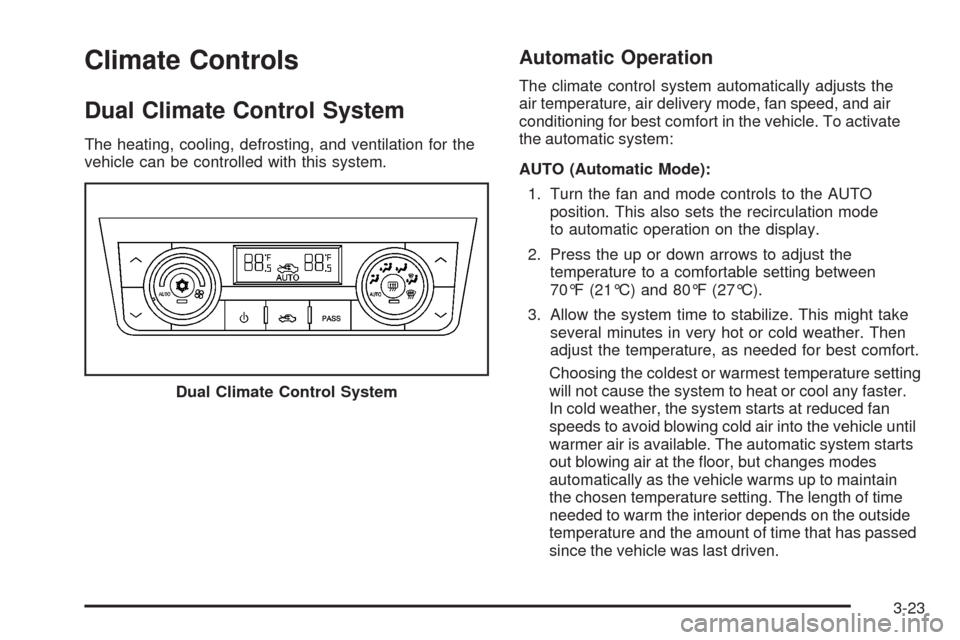
Climate Controls
Dual Climate Control System
The heating, cooling, defrosting, and ventilation for the
vehicle can be controlled with this system.
Automatic Operation
The climate control system automatically adjusts the
air temperature, air delivery mode, fan speed, and air
conditioning for best comfort in the vehicle. To activate
the automatic system:
AUTO (Automatic Mode):
1. Turn the fan and mode controls to the AUTO
position. This also sets the recirculation mode
to automatic operation on the display.
2. Press the up or down arrows to adjust the
temperature to a comfortable setting between
70°F (21°C) and 80°F (27°C).
3. Allow the system time to stabilize. This might take
several minutes in very hot or cold weather. Then
adjust the temperature, as needed for best comfort.
Choosing the coldest or warmest temperature setting
will not cause the system to heat or cool any faster.
In cold weather, the system starts at reduced fan
speeds to avoid blowing cold air into the vehicle until
warmer air is available. The automatic system starts
out blowing air at the �oor, but changes modes
automatically as the vehicle warms up to maintain
the chosen temperature setting. The length of time
needed to warm the interior depends on the outside
temperature and the amount of time that has passed
since the vehicle was last driven. Dual Climate Control System
3-23
Page 164 of 448
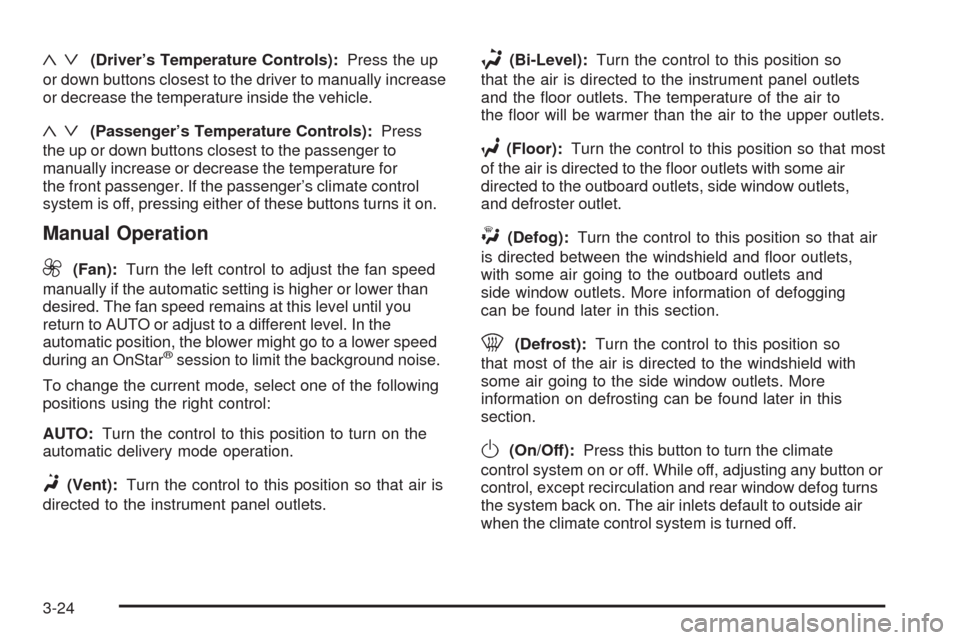
«ª(Driver’s Temperature Controls):Press the up
or down buttons closest to the driver to manually increase
or decrease the temperature inside the vehicle.
«ª(Passenger’s Temperature Controls):Press
the up or down buttons closest to the passenger to
manually increase or decrease the temperature for
the front passenger. If the passenger’s climate control
system is off, pressing either of these buttons turns it on.
Manual Operation
9(Fan):Turn the left control to adjust the fan speed
manually if the automatic setting is higher or lower than
desired. The fan speed remains at this level until you
return to AUTO or adjust to a different level. In the
automatic position, the blower might go to a lower speed
during an OnStar
®session to limit the background noise.
To change the current mode, select one of the following
positions using the right control:
AUTO:Turn the control to this position to turn on the
automatic delivery mode operation.
F(Vent):Turn the control to this position so that air is
directed to the instrument panel outlets.
*(Bi-Level):Turn the control to this position so
that the air is directed to the instrument panel outlets
and the �oor outlets. The temperature of the air to
the �oor will be warmer than the air to the upper outlets.
7(Floor):Turn the control to this position so that most
of the air is directed to the �oor outlets with some air
directed to the outboard outlets, side window outlets,
and defroster outlet.
W(Defog):Turn the control to this position so that air
is directed between the windshield and �oor outlets,
with some air going to the outboard outlets and
side window outlets. More information of defogging
can be found later in this section.
0(Defrost):Turn the control to this position so
that most of the air is directed to the windshield with
some air going to the side window outlets. More
information on defrosting can be found later in this
section.
O(On/Off):Press this button to turn the climate
control system on or off. While off, adjusting any button or
control, except recirculation and rear window defog turns
the system back on. The air inlets default to outside air
when the climate control system is turned off.
3-24
Page 165 of 448
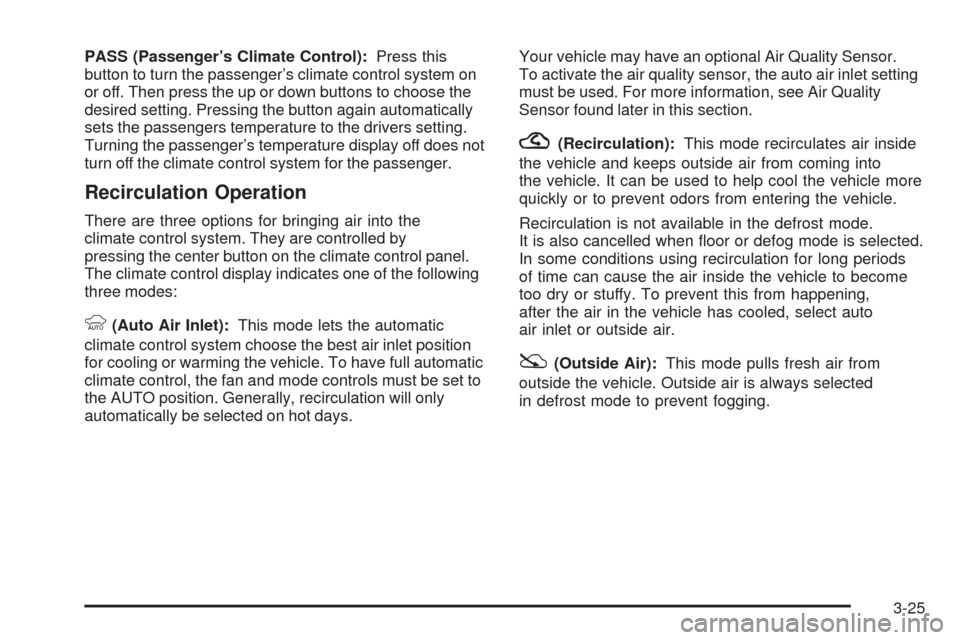
PASS (Passenger’s Climate Control):Press this
button to turn the passenger’s climate control system on
or off. Then press the up or down buttons to choose the
desired setting. Pressing the button again automatically
sets the passengers temperature to the drivers setting.
Turning the passenger’s temperature display off does not
turn off the climate control system for the passenger.
Recirculation Operation
There are three options for bringing air into the
climate control system. They are controlled by
pressing the center button on the climate control panel.
The climate control display indicates one of the following
three modes:
9(Auto Air Inlet):This mode lets the automatic
climate control system choose the best air inlet position
for cooling or warming the vehicle. To have full automatic
climate control, the fan and mode controls must be set to
the AUTO position. Generally, recirculation will only
automatically be selected on hot days.Your vehicle may have an optional Air Quality Sensor.
To activate the air quality sensor, the auto air inlet setting
must be used. For more information, see Air Quality
Sensor found later in this section.
?(Recirculation):This mode recirculates air inside
the vehicle and keeps outside air from coming into
the vehicle. It can be used to help cool the vehicle more
quickly or to prevent odors from entering the vehicle.
Recirculation is not available in the defrost mode.
It is also cancelled when �oor or defog mode is selected.
In some conditions using recirculation for long periods
of time can cause the air inside the vehicle to become
too dry or stuffy. To prevent this from happening,
after the air in the vehicle has cooled, select auto
air inlet or outside air.
:(Outside Air):This mode pulls fresh air from
outside the vehicle. Outside air is always selected
in defrost mode to prevent fogging.
3-25
Page 166 of 448
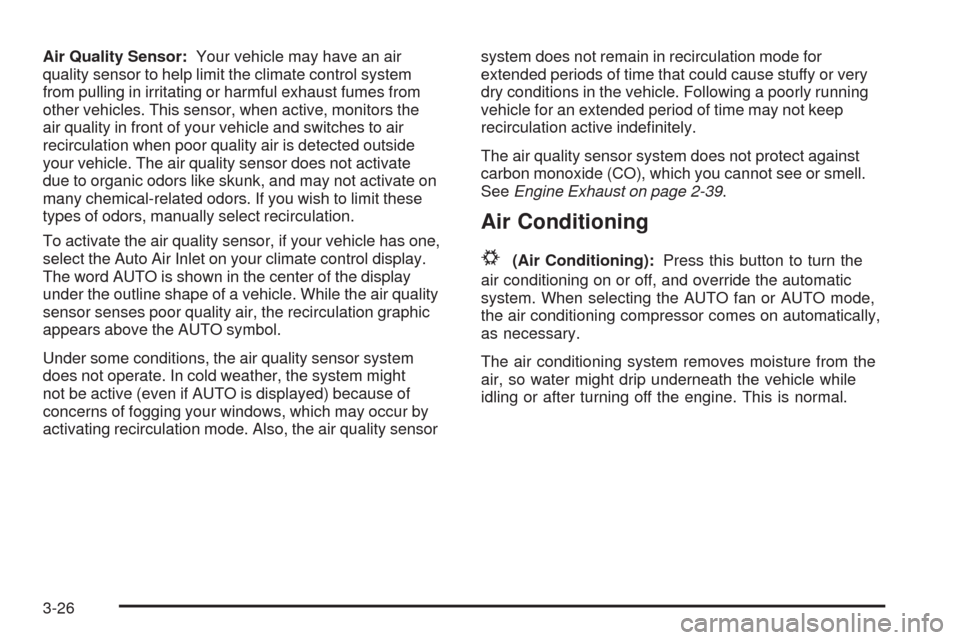
Air Quality Sensor:Your vehicle may have an air
quality sensor to help limit the climate control system
from pulling in irritating or harmful exhaust fumes from
other vehicles. This sensor, when active, monitors the
air quality in front of your vehicle and switches to air
recirculation when poor quality air is detected outside
your vehicle. The air quality sensor does not activate
due to organic odors like skunk, and may not activate on
many chemical-related odors. If you wish to limit these
types of odors, manually select recirculation.
To activate the air quality sensor, if your vehicle has one,
select the Auto Air Inlet on your climate control display.
The word AUTO is shown in the center of the display
under the outline shape of a vehicle. While the air quality
sensor senses poor quality air, the recirculation graphic
appears above the AUTO symbol.
Under some conditions, the air quality sensor system
does not operate. In cold weather, the system might
not be active (even if AUTO is displayed) because of
concerns of fogging your windows, which may occur by
activating recirculation mode. Also, the air quality sensorsystem does not remain in recirculation mode for
extended periods of time that could cause stuffy or very
dry conditions in the vehicle. Following a poorly running
vehicle for an extended period of time may not keep
recirculation active inde�nitely.
The air quality sensor system does not protect against
carbon monoxide (CO), which you cannot see or smell.
SeeEngine Exhaust on page 2-39.
Air Conditioning
#
(Air Conditioning):Press this button to turn the
air conditioning on or off, and override the automatic
system. When selecting the AUTO fan or AUTO mode,
the air conditioning compressor comes on automatically,
as necessary.
The air conditioning system removes moisture from the
air, so water might drip underneath the vehicle while
idling or after turning off the engine. This is normal.
3-26
Page 167 of 448
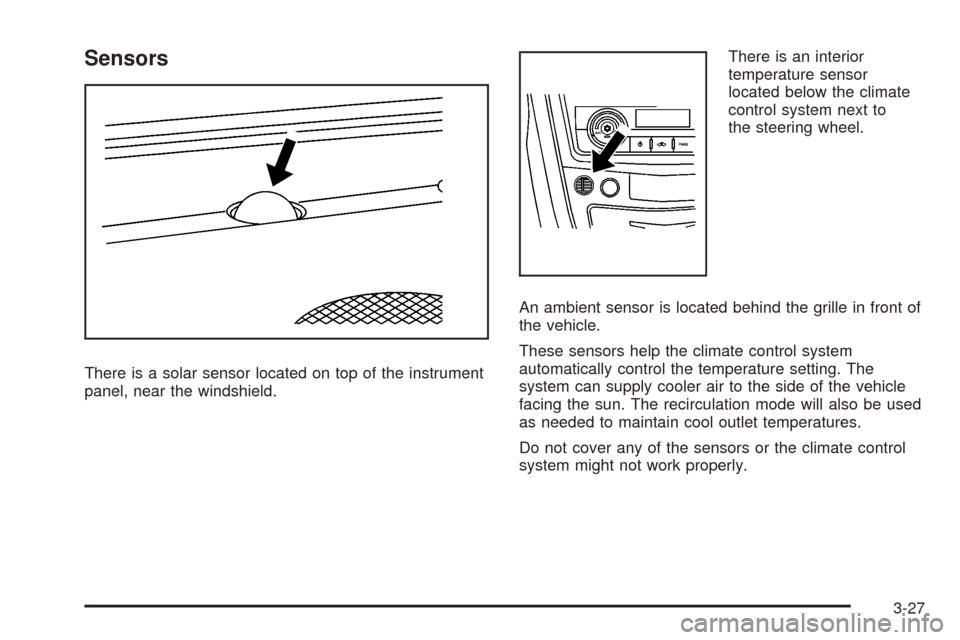
Sensors
There is a solar sensor located on top of the instrument
panel, near the windshield.There is an interior
temperature sensor
located below the climate
control system next to
the steering wheel.
An ambient sensor is located behind the grille in front of
the vehicle.
These sensors help the climate control system
automatically control the temperature setting. The
system can supply cooler air to the side of the vehicle
facing the sun. The recirculation mode will also be used
as needed to maintain cool outlet temperatures.
Do not cover any of the sensors or the climate control
system might not work properly.
3-27
Page 168 of 448
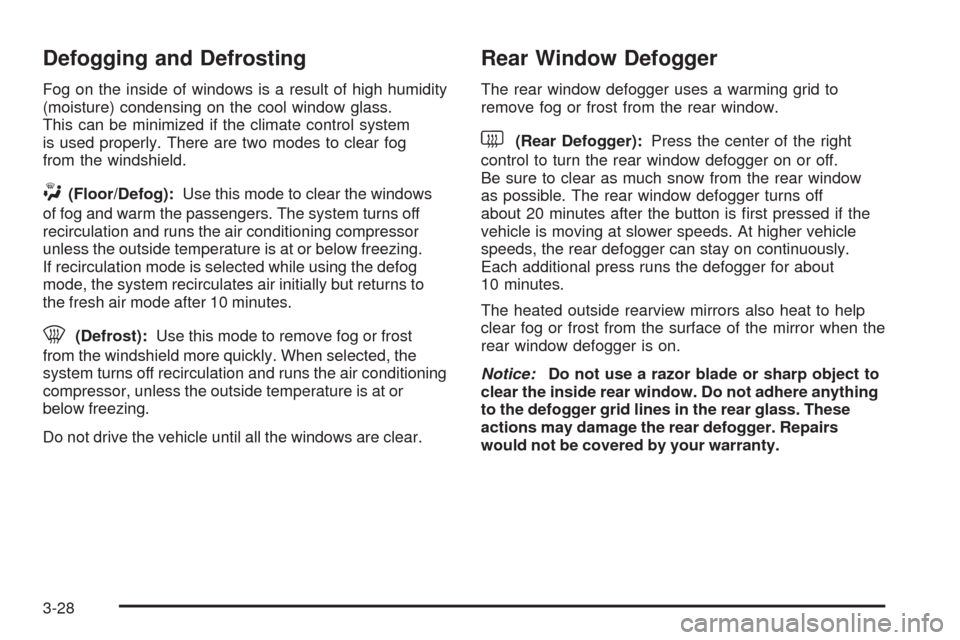
Defogging and Defrosting
Fog on the inside of windows is a result of high humidity
(moisture) condensing on the cool window glass.
This can be minimized if the climate control system
is used properly. There are two modes to clear fog
from the windshield.
W(Floor/Defog):Use this mode to clear the windows
of fog and warm the passengers. The system turns off
recirculation and runs the air conditioning compressor
unless the outside temperature is at or below freezing.
If recirculation mode is selected while using the defog
mode, the system recirculates air initially but returns to
the fresh air mode after 10 minutes.
0(Defrost):Use this mode to remove fog or frost
from the windshield more quickly. When selected, the
system turns off recirculation and runs the air conditioning
compressor, unless the outside temperature is at or
below freezing.
Do not drive the vehicle until all the windows are clear.
Rear Window Defogger
The rear window defogger uses a warming grid to
remove fog or frost from the rear window.
<(Rear Defogger):Press the center of the right
control to turn the rear window defogger on or off.
Be sure to clear as much snow from the rear window
as possible. The rear window defogger turns off
about 20 minutes after the button is �rst pressed if the
vehicle is moving at slower speeds. At higher vehicle
speeds, the rear defogger can stay on continuously.
Each additional press runs the defogger for about
10 minutes.
The heated outside rearview mirrors also heat to help
clear fog or frost from the surface of the mirror when the
rear window defogger is on.
Notice:Do not use a razor blade or sharp object to
clear the inside rear window. Do not adhere anything
to the defogger grid lines in the rear glass. These
actions may damage the rear defogger. Repairs
would not be covered by your warranty.
3-28
Page 169 of 448
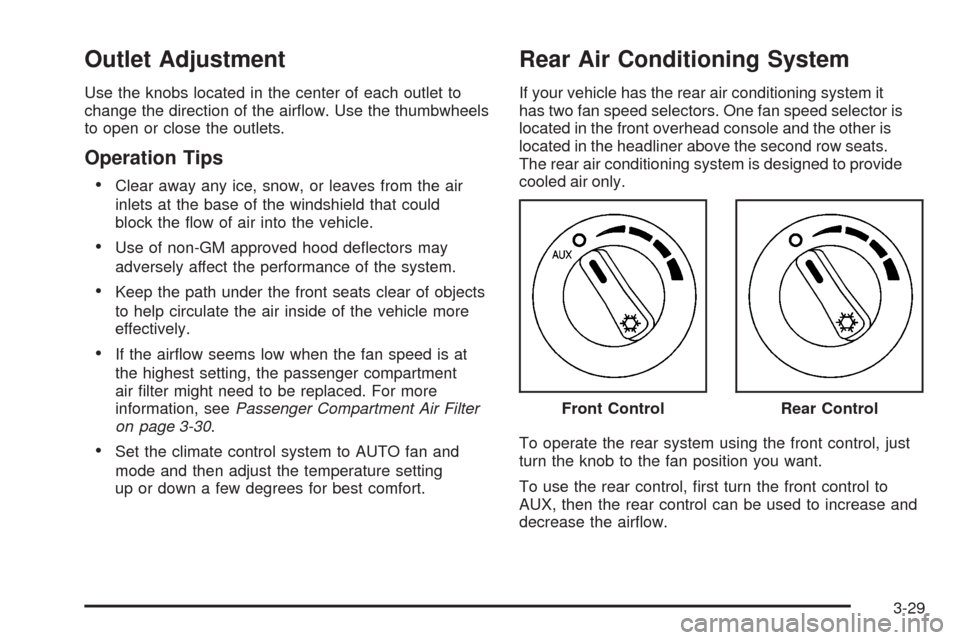
Outlet Adjustment
Use the knobs located in the center of each outlet to
change the direction of the air�ow. Use the thumbwheels
to open or close the outlets.
Operation Tips
Clear away any ice, snow, or leaves from the air
inlets at the base of the windshield that could
block the �ow of air into the vehicle.
Use of non-GM approved hood de�ectors may
adversely affect the performance of the system.
Keep the path under the front seats clear of objects
to help circulate the air inside of the vehicle more
effectively.
If the air�ow seems low when the fan speed is at
the highest setting, the passenger compartment
air �lter might need to be replaced. For more
information, seePassenger Compartment Air Filter
on page 3-30.
Set the climate control system to AUTO fan and
mode and then adjust the temperature setting
up or down a few degrees for best comfort.
Rear Air Conditioning System
If your vehicle has the rear air conditioning system it
has two fan speed selectors. One fan speed selector is
located in the front overhead console and the other is
located in the headliner above the second row seats.
The rear air conditioning system is designed to provide
cooled air only.
To operate the rear system using the front control, just
turn the knob to the fan position you want.
To use the rear control, �rst turn the front control to
AUX, then the rear control can be used to increase and
decrease the air�ow.Front Control
Rear Control
3-29
Page 170 of 448
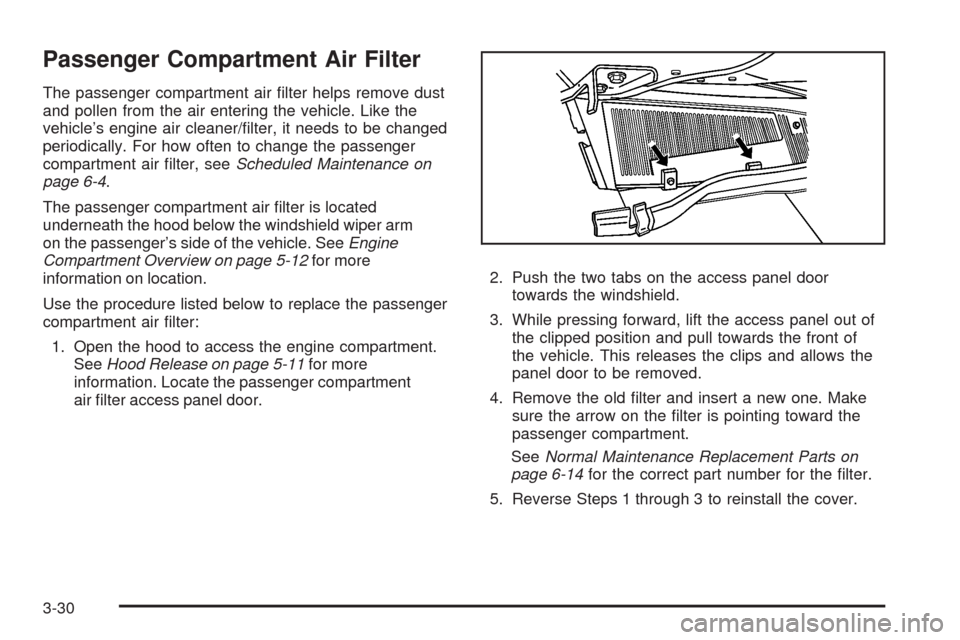
Passenger Compartment Air Filter
The passenger compartment air �lter helps remove dust
and pollen from the air entering the vehicle. Like the
vehicle’s engine air cleaner/�lter, it needs to be changed
periodically. For how often to change the passenger
compartment air �lter, seeScheduled Maintenance on
page 6-4.
The passenger compartment air �lter is located
underneath the hood below the windshield wiper arm
on the passenger’s side of the vehicle. SeeEngine
Compartment Overview on page 5-12for more
information on location.
Use the procedure listed below to replace the passenger
compartment air �lter:
1. Open the hood to access the engine compartment.
SeeHood Release on page 5-11for more
information. Locate the passenger compartment
air �lter access panel door.2. Push the two tabs on the access panel door
towards the windshield.
3. While pressing forward, lift the access panel out of
the clipped position and pull towards the front of
the vehicle. This releases the clips and allows the
panel door to be removed.
4. Remove the old �lter and insert a new one. Make
sure the arrow on the �lter is pointing toward the
passenger compartment.
SeeNormal Maintenance Replacement Parts on
page 6-14for the correct part number for the �lter.
5. Reverse Steps 1 through 3 to reinstall the cover.
3-30